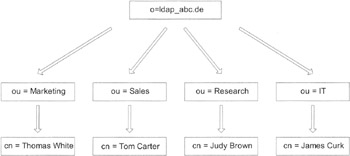Example: An Enterprise with a Few Departments
|
| < Day Day Up > |
|
First of all, let us look at the problem at hand. We will use a classic example to illustrate an LDAP application: a directory of employees. Note that this is a widely used LDAP application, but it is not the only one. We will see other applications later in this book.
Let us assume that we have an enterprise named ldap_abc. To simplify, let this enterprise work in only one country. The enterprise ldap_abc has a number of departments, and a certain number of people work in each department. Our goal is to find the phone number of a certain employee, knowing surname and given name. For now, we will not concentrate much on the overall design. This aspect will be treated in Chapter 9. This chapter is only intended to give a quick overview of what you can do with LDAP. Nor will we care about performance or more sophisticated queries, such as finding a Mr. Smith working in Australia whose given name begins with A and who does not have a fax. Be patient, we will address these and other arguments later.
The first job on our to-do list is to reproduce the hierarchical structure of our enterprise in the tree structure in LDAP. The root of this treelike data structure defines the "namespace" within which we will work. Now you may well ask, "What is our tree made of?" The answer is that the tree is made of objects. Exhibit 1 shows a small part of the tree.

Exhibit 1: Example Directory Tree
Looking at Exhibit 1, you may wonder what o=1dap_abc.de and the other abbreviations mean. We will discuss this in Chapter 3 when we look at the theory behind LDAP. For now it is enough to know that o stands for organization, ou for organizational unit and cn for common name, i.e., surname. All these abbreviations must be declared in the schema defining the data structures the directory can hold.
Now let us have a look at the individual objects: The root of the tree is the enterprise itself, ldap_abc. The root branches out into individual departments. To simplify the discussion, we will limit ourselves to four: Marketing, Sales, Research, and IT. Note that every department is one object, as is the root element. What is missing now are the employees. Every employee is an object under the corresponding department.
In developing our design, we learned that the LDAP database is organized in a tree structure of objects. This tree spans the namespace we are moving in. Now that we have completed our design, we can proceed to implement the single objects.
|
| < Day Day Up > |
|
EAN: 2147483647
Pages: 149